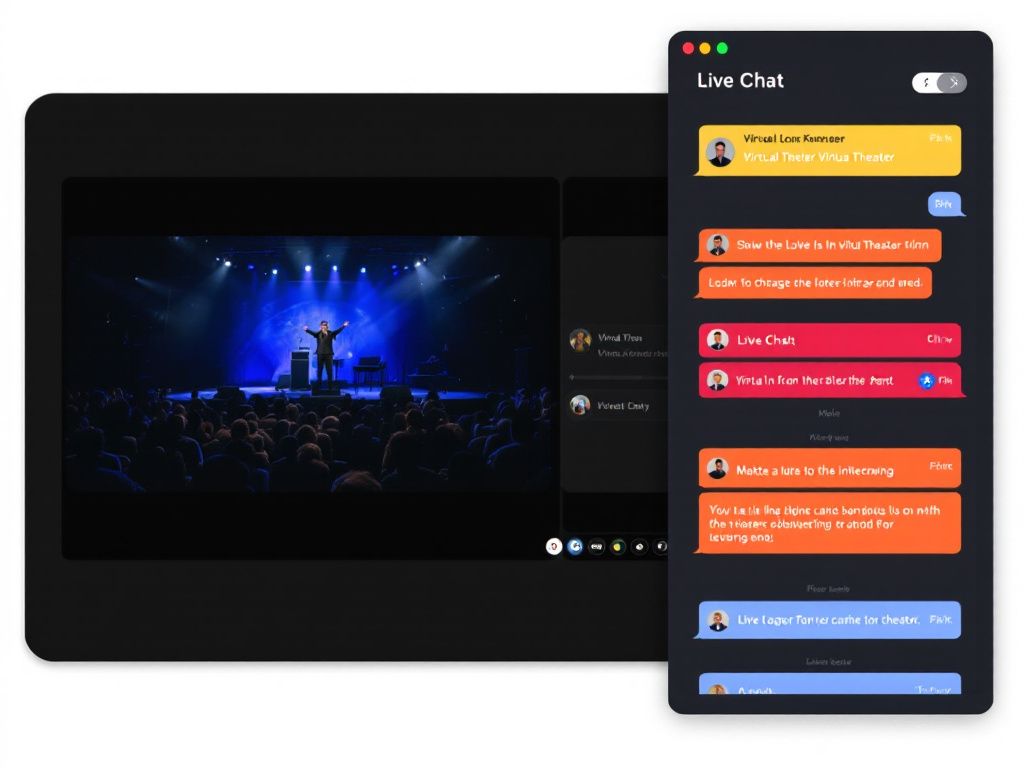Hey there, theater enthusiasts! Here’s a question for you: have you ever tried to catch a live theater show from the comfort of your own home? Virtual theater shows are becoming a thing, and I’m here to guide you through it. Let’s break down the essentials of taking that compelling onstage experience and delivering it virtually without losing its magic.
Virtual theaters aren’t just about pressing record on a camera and sharing it online. It’s an art form in itself, demanding unique production techniques, creative staging, and a keen understanding of digital interaction. Let’s dive into what makes a virtual theater performance a memorable event, shall we?
What is Virtual Theater, Anyway?
Virtual theater is an adaptation of traditional stage performances for the digital medium. You might be asking yourself, why should I bother with it? Well, virtual theater offers accessibility. It opens up a world where physical distance no longer stops you from experiencing global plays from your couch.
Embrace the Digital Differences
One key takeaway is that virtual theater isn’t just regular theater on a screen. It has its own set of dynamics and a need for creative twists. This brings us to our first key element: **the adaptation of material for virtual performance**.
Unlike an in-person performance, where a live audience provides immediate feedback, a virtual show demands that performers re-envision their connection with viewers. The real magic happens when actors and directors understand these differences and innovate.
Building Your Virtual Stage
Space Planning for a Digital Performance

Creating a virtual stage requires you to think beyond the traditional dimensions. Space in a digital format transforms how a story is told. Instead of one fixed viewpoint, the performer can play with close-ups, angles, and editing to emphasize different storytelling elements.
Consider setting up your space with not just distance in mind but intimacy too. How can your viewer be brought in closer to the scene emotionally? Here’s an idea: employ camera framing techniques akin to film. It’s like dancing with your lens to craft each moment beautifully.
Lights, Camera, Internet!
Your setup needs to be just right. Adequate lighting changes everything in a video production. Natural light is wonderful but inconsistent. Reliable LED lights can illuminate the performance space evenly and maintain the show’s aesthetic.
Don’t forget camera quality. Mind you, a high-definition camera brings the intricacies of your performance to life. However, the star of this show may be your internet speed. Ensure you have a stable connection; after all, buffering is no one’s favorite intermission.
Getting Performance-Ready: Preparing Your Team
Ensuring your cast and crew understand the intricacies of virtual theater is as crucial as any other play preparation.
Adapting Performances for the Screen
Actors need to adjust their skills for the screen. It’s not what they usually execute onstage; instead, it’s about subtle shifts, expressions intensified by close-up shots, and pauses that translate emotions across the digital divide.
**Rehearsals are more vital than ever**, with dynamic tech elements typical of virtual shows. Prepare your team for the specifics of being seen up-close and personal. This might mean putting a new spin on in-person rehearsals by focusing on camera-friendly interactions.
Tech Savvy Cast and Crew

We live in a digital world folks! So, having a tech-savvy team is crucial. Ensure each member is comfortable with the equipment and software used for your production.
Your tech crew should understand sound mixing, video recording, and live streaming, it changes the game when you’re running a virtual theater show. If someone isn’t particularly tech-savvy, pair them with someone more experienced for support and learning.
Interactive Elements: Bridging the Audience Gap
Engaging Digital Audience
Interaction is rule number one in theater; the audience must feel involved. Virtual performances lose live audience laughter, applause, and gasps. How can we fill that void? Let’s feature live chat functionalities or social media integration.
You might want to direct post-performance discussions or implement interactive polls during live streams. This way, your audience remains part of the conversation and engaged throughout the show.
Building Connections
Don’t underestimate the power of email lists and social media. Before the show, tease out some behind-the-scenes snippets to rope your audience in. Send reminders about the performance day and offer post-show options like recorded sessions or exclusive cast interviews.
Try out “meeting the cast” sessions, where viewers get a backstage pass into actors’ perspectives. Bridging the digital and real world creates a community feel within your audience.
Challenges and Roadblocks in Virtual Theater

It’s not all glitz and glamor. Virtual theater performance bumps into certain hurdles you should know.
Connection Issues
Technical glitches are a reality. A dropped connection in the middle of a stream can kill the momentum of a gripping narrative. It’s imperative to have backups—either pre-record segments or have tech personnel on standby to troubleshoot issues in real-time.
Production Cost Vs. Profit
Balancing a limited budget while providing a high-quality production is a frequent dilemma. Consider entry fees or premium memberships to cover costs and sustain the creative process without sacrificing quality.
Why Go Virtual? Opportunities You Shouldn’t Miss
Despite the hurdles, going virtual opens numerous doors. Perform your plays globally, grow your audience, and engage with your supporters in new, digital ways. Plus, it’s eco-friendly!
Expand your production’s reach, test market reactions, and collaborate with globally based creatives. It’s like having a world stage while reducing logistical no-brainers like venue booking or travel expenses.
Final Thoughts: Create a Memorable Virtual Theater Experience
Here’s the scoop: creating a successful virtual theater show is all about innovation, adaptation, and interaction. Adapt performances to connect emotionally through screens. Harness tech tools, embrace interactive elements, and tackle tech hiccups. These steps bridge performance art and digital innovation smoothly.
Remember, art transcends boundaries, even screens. With good planning, commitment, and creativity, your virtual theater show could breathe new life into digital entertainment spaces. Ready to give it a try? Step onto the virtual stage and let your story shine!
Frequently Asked Questions
How far in advance should I start preparing my skin for an event?
It is recommended to start preparing your skin at least 4 weeks before the event. This timeframe allows for adequate hydration, quality sleep, a balanced diet rich in skin-loving nutrients, and the incorporation of exercise and stress management techniques to enhance your skin’s natural glow[1].
What skincare treatments should I consider before an event?
Before an event, consider treatments such as facials, chemical peels, and hydrating treatments like HydraFacial. For more intense treatments like laser resurfacing or microneedling with PRP, it is best to schedule these 2-3 months in advance to allow for full recovery and optimal results[3][4].
How can I maintain my skin health in the days leading up to an event?
In the days leading up to your event, avoid inflammatory foods, practice facial massage for lymphatic drainage, and ensure you are well-hydrated. Also, limit processed foods, dairy, and excessive salt, and opt for anti-inflammatory foods like turmeric and ginger[1].
When should I get a facial before an event to avoid any adverse side effects?
It is advisable to get a facial at least one week before the event to avoid any potential side effects such as redness or irritation. Treatments like HydraFacial or dermaplaning, which have no downtime, are ideal for the final week before your event[4][5].
References










